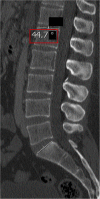Increased pelvic incidence may lead to arthritis and sagittal orientation of the facet joints at the lower lumbar spine
- PMID: 24188071
- PMCID: PMC4228336
- DOI: 10.1186/1471-2342-13-34
Increased pelvic incidence may lead to arthritis and sagittal orientation of the facet joints at the lower lumbar spine
Abstract
Background: Correct sagittal alignment with a balanced pelvis and spine is crucial in the management of spinal disorders. The pelvic incidence (PI) describes the sagittal pelvic alignment and is position-independent. It has barely been investigated on CT scans. Furthermore, no studies have focused on the association between PI and facet joint (FJ) arthritis and orientation. Therefore, our goal was to clarify the remaining issues about PI in regard to (1) physiologic values, (2) age, (3) gender, (4) lumbar lordosis (LL) and (5) FJ arthritis and orientation using CT scans.
Methods: We retrospectively analyzed CT scans of 620 individuals, with a mean age of 43 years, who presented to our traumatology department and underwent a whole body CT scan, between 2008 and 2010. The PI was determined on sagittal CT planes of the pelvis by measuring the angle between the hip axis to an orthogonal line originating at the center of the superior end plate axis of the first sacral vertebra. We also evaluated LL, FJ arthritis and orientation of the lumbar spine.
Results: 596 individuals yielded results for (1) PI with a mean of 50.8°. There was no significant difference for PI and (2) age, nor (3) gender. PI was significantly and linearly correlated with (4) LL (p = < 0.0001). Interestingly, PI and (5) FJ arthritis displayed a significant and linear correlation (p = 0.0062) with a cut-off point at 50°. An increased PI was also significantly associated with more sagitally oriented FJs at L5/S1 (p = 0.01).
Conclusion: PI is not correlated with age nor gender. However, this is the first report showing that PI is significantly and linearly associated with LL, FJ arthritis and more sagittal FJ orientation at the lower lumbar spine. This may be caused by a higher contact force on the lower lumbar FJs by an increased PI. Once symptomatic or in the event of spinal trauma, patients with increased PI and LL could benefit from corrective surgery and spondylodesis.
Figures









Similar articles
-
Hyperlordosis is Associated With Facet Joint Pathology at the Lower Lumbar Spine.Clin Spine Surg. 2017 Apr;30(3):129-135. doi: 10.1097/BSD.0b013e3182aab266. Clin Spine Surg. 2017. PMID: 28323692
-
Obesity measured by outer abdominal fat may cause facet joint arthritis at the lumbar spine.J Back Musculoskelet Rehabil. 2015;28(1):85-91. doi: 10.3233/BMR-140495. J Back Musculoskelet Rehabil. 2015. PMID: 24968801
-
Correlations between the feature of sagittal spinopelvic alignment and facet joint degeneration: a retrospective study.BMC Musculoskelet Disord. 2016 Aug 15;17(1):341. doi: 10.1186/s12891-016-1193-6. BMC Musculoskelet Disord. 2016. PMID: 27528107 Free PMC article.
-
Relationship Between Lumbar Lordosis and Pelvic Incidence in the Adolescent Patient: Normal Cohort Analysis and Literature Comparison.Spine Deform. 2018 Sep-Oct;6(5):529-536. doi: 10.1016/j.jspd.2018.02.002. Spine Deform. 2018. PMID: 30122388 Review.
-
Biomechanical analysis of the spino-pelvic organization and adaptation in pathology.Eur Spine J. 2011 Sep;20 Suppl 5(Suppl 5):609-18. doi: 10.1007/s00586-011-1928-x. Epub 2011 Aug 2. Eur Spine J. 2011. PMID: 21809016 Free PMC article. Review.
Cited by
-
Percutaneous endoscopic lumbar discectomy for single and double segment lumbar disc herniation with sciatic scoliosis in adults: a retrospective study.BMC Surg. 2024 Jan 31;24(1):41. doi: 10.1186/s12893-024-02314-5. BMC Surg. 2024. PMID: 38297255 Free PMC article.
-
Quantitative evaluation of correlation between lumbosacral lordosis and pelvic incidence in standing position among asymptomatic Asian adults: a prospective study.Sci Rep. 2022 Nov 8;12(1):18965. doi: 10.1038/s41598-022-21840-x. Sci Rep. 2022. PMID: 36347920 Free PMC article.
-
Locomotive Syndrome and Lumbar Spine Disease: A Systematic Review.J Clin Med. 2022 Feb 27;11(5):1304. doi: 10.3390/jcm11051304. J Clin Med. 2022. PMID: 35268395 Free PMC article. Review.
-
Correlates of bone mineral density and sagittal spinal balance in the aged.Ann Rehabil Med. 2015 Feb;39(1):100-7. doi: 10.5535/arm.2015.39.1.100. Epub 2015 Feb 28. Ann Rehabil Med. 2015. PMID: 25750878 Free PMC article.
-
Differences in lumbar and pelvic parameters among African American, Caucasian and Asian populations.Eur Spine J. 2018 Dec;27(12):2990-2998. doi: 10.1007/s00586-018-5743-5. Epub 2018 Aug 24. Eur Spine J. 2018. PMID: 30143898
References
Publication types
MeSH terms
LinkOut - more resources
Full Text Sources
Other Literature Sources
Medical
Research Materials
Miscellaneous

